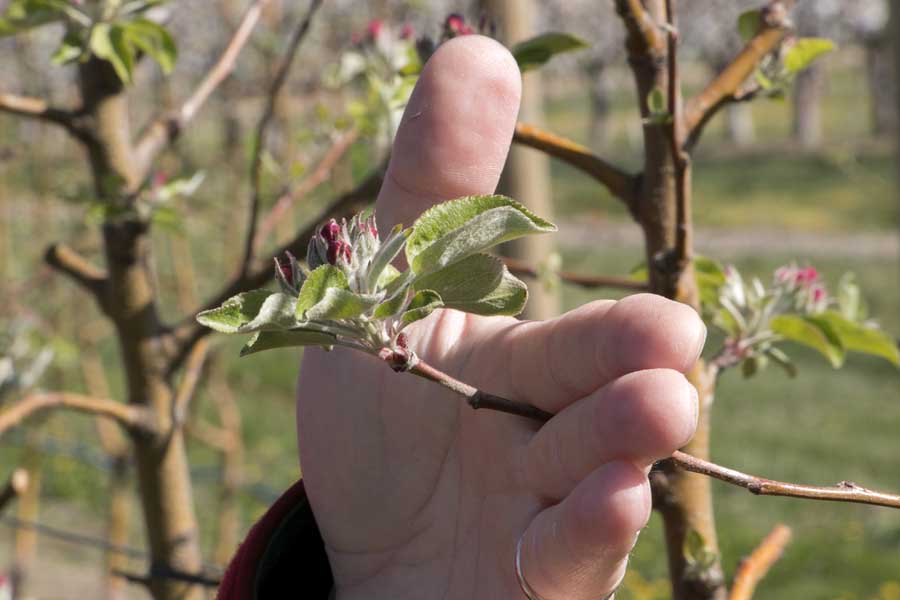Good pruning is often seen as an art, but apple and pear growers would benefit from letting the science of physiology inform their pruning strategy, Stefano Musacchi, research pomologist with Washington State University Tree Fruit Research and Extension Center in Wenatchee, Washington, said at the Washington State Tree Fruit Association’s annual meeting in December.
His talk focused on strategies to minimize the effect of apical dominance, how to bend branches at the optimum angle to encourage more flowers and the merits of a technique known as “click” pruning he began to introduce to Washington growers when he joined WSU in 2013.
Developed about 20 years ago in Northern Europe, click pruning is a simple head back cut on 1-year-old shoots that leaves just two or three regenerative buds on the branch.
Musacchi promotes it as a means to control vigor and reduce blind wood. It works because the tree responds to the cut by increasing sap flow to the remaining stub, increasing bud swelling and shoot growth. That’s reflected in its Spanish name Musacchi also uses in his talk: tira savia, to pull sap.
The cut can be used both to manage overly vigorous trees and to encourage more vigor in weak trees, depending on the locations cut. “You drive the vigor where you want, not where the tree would like to grow,” Musacchi said.
It’s a particularly beneficial technique for pruning pears, which are prone to blind wood that no longer bears fruit, but the technique is also useful for managing certain apple cultivars, including WA 38, the new Washington State University variety to be sold under the name Cosmic Crisp, Musacchi said.
Pears
The click cut removes the apical dominance of the 1-year-shoot and pushes the vigor pears need to produce quality fruit closer to the trunk.
This is especially important in Bartlett, which needs dynamic pruning because it tends to produce most of its fruit on one-year shoots, Musacchi said. Click pruning on a three-year cycle maintains a high level of young, productive wood on your trees.
“The natural tendency of Bartlett is that the branches bend down and the base part becomes blind, which is what we don’t want,” he said in an interview after his talk. “That drives the fruit production outside.”
And the pears produced on the tips of the young, outside shoots are usually smaller, so from an economic standpoint, you want to encourage fruit production closer to the trunk.
“If you have a problem of blind wood, the click can be used to fix it, and you will have a wonderful reaction of strong shoots,” Musacchi said. “On pears that need that vigor to produce good-sized fruit, the difference is huge.”
The pruning needs of Bosc and d’Anjou pears are different because they produce most of their fruit on older wood, but click pruning can benefit those cultivars as well if standard pruning practices — thinning branches but not heading cuts — are producing too much blind wood.
Apples

“Click” pruning involves tipping the branches of 1-year-old wood, leaving two or three vegetative buds at the base of the shoot shorted, as Stefano Musacchi demonstrates last April at the Irrigated Agricultural Research and Extension Center in Prosser. The remaining buds will grow with a lot of vigor, minimizing blind wood by the swelling of the basal buds of the branch and, with years of repeated pruning, maintain the branch in the space assigned. (Ross Courtney/Good Fruit Grower)
In apples, the click technique is best used on the main scaffold of branches in the lower part of the tree, Musacchi said. Use in the upper section depends on the cultivar, its vigor and fruiting habit.
The technique does benefit tip-bearing apple trees which, like Bartlett pears, tend to accumulate blind wood. And it can be used in both low- and high-density orchards to increase light penetration and manage vigor.
Using the click cut at the top of the tree, leaving just one shoot with a few regenerative buds, will drive growth there, which you can then easily manage by cutting it back the same way the following year, Musacchi said in his presentation.
But it’s not a one size fits all situation, he cautioned in a follow-up interview.
“If I want to drive the vigor in the top of the tree, I will click prune the axis,” Musacchi said. “If my tree is well balanced, I can handle the top with a lateral cut over a shoot with terminal flower buds.”
Musacchi recommended click pruning for WA 38, both to prevent blind wood and to ensure that enough light is penetrating the canopy for the fruit to develop its color.
Maximizing light penetration in trees is critical to the high-latitude growing of Northern Europe, where the technique was developed.
He also recommends click pruning for bi-axis orchards, a system he helped develop while at the University of Bologna. Compared to lateral cuts, the technique encourages new shoot growth in the basal part of the tree. •
– by Kate Prengaman






I’ve misplaced my issue (which I believe was one of the Jan. 2017 ones) that featured a young German woman who I believe came to WA as an intern, and was returning to her family’s orchard near Hamburg, Germany.
My parents are German immigrants, and I am going to visit German relatives in March who are field crop farmers not far from Hamburg, and I’d like to contact that orchard in hopes of visiting there.
Could you please give me at least the info. that was in that article, or a link to the article (as it is not yet archived on your site), so that I may make that contact:
Thank you!
Richard,
That video interview is on our web site.
https://www.youtube.com/watch?v=OazVYaepmac